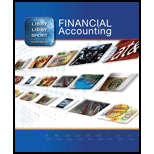
Financial Accounting, 8th Edition
8th Edition
ISBN: 9780078025556
Author: Robert Libby, Patricia Libby, Daniel Short
Publisher: McGraw-Hill Education
expand_more
expand_more
format_list_bulleted
Question
Chapter 13, Problem 4MCQ
To determine
Identify the correct option which indicates the positive financial leverage percentage.
Expert Solution & Answer
Want to see the full answer?
Check out a sample textbook solution
Students have asked these similar questions
Financial Accounting
How much does the item cost before tax on these financial accounting question?
General Accounting
Chapter 13 Solutions
Financial Accounting, 8th Edition
Ch. 13 - Prob. 1QCh. 13 - Prob. 2QCh. 13 - Prob. 3QCh. 13 - Prob. 4QCh. 13 - What is ratio analysis? Why is it useful?Ch. 13 - What are component percentages? Why are they...Ch. 13 - Prob. 7QCh. 13 - Prob. 8QCh. 13 - Prob. 9QCh. 13 - Prob. 10Q
Ch. 13 - Prob. 11QCh. 13 - Prob. 12QCh. 13 - Prob. 13QCh. 13 - A company has total assets of 500,000 and...Ch. 13 - Prob. 2MCQCh. 13 - Prob. 3MCQCh. 13 - Prob. 4MCQCh. 13 - Prob. 5MCQCh. 13 - Prob. 6MCQCh. 13 - Prob. 7MCQCh. 13 - Prob. 8MCQCh. 13 - Prob. 9MCQCh. 13 - Prob. 10MCQCh. 13 - Prob. 1MECh. 13 - Prob. 2MECh. 13 - Prob. 3MECh. 13 - Prob. 4MECh. 13 - Prob. 5MECh. 13 - Prob. 6MECh. 13 - Prob. 7MECh. 13 - Prob. 8MECh. 13 - Prob. 9MECh. 13 - Prob. 10MECh. 13 - Prob. 1ECh. 13 - Prob. 2ECh. 13 - Prob. 3ECh. 13 - Prob. 4ECh. 13 - Prob. 5ECh. 13 - Prob. 6ECh. 13 - Prob. 7ECh. 13 - Prob. 8ECh. 13 - Prob. 9ECh. 13 - Prob. 10ECh. 13 - Prob. 11ECh. 13 - Prob. 12ECh. 13 - Prob. 13ECh. 13 - Prob. 1PCh. 13 - Prob. 2PCh. 13 - Prob. 4PCh. 13 - Prob. 5PCh. 13 - Prob. 6PCh. 13 - Prob. 7PCh. 13 - Prob. 8PCh. 13 - Prob. 9PCh. 13 - Prob. 10PCh. 13 - Prob. 1APCh. 13 - Prob. 2APCh. 13 - Prob. 3APCh. 13 - Prob. 4APCh. 13 - Prob. 5APCh. 13 - Prob. 6APCh. 13 - Prob. 1CPCh. 13 - Prob. 2CPCh. 13 - Prob. 3CPCh. 13 - Prob. 4CPCh. 13 - Prob. 5CPCh. 13 - Prob. 6CP
Knowledge Booster
Learn more about
Need a deep-dive on the concept behind this application? Look no further. Learn more about this topic, accounting and related others by exploring similar questions and additional content below.Similar questions
- Direct Labor Variance Karina will make 5,000 jackets with standard quantity of leather per jacket of 120.03 square inches of material @ $0.25/square inch. The actual quantity of leather per jacket for those 5,000 jackets produced was 122.53 square inches of material @ $0.24/square inch. The standard labor to produce each jacket is one hour for each jacket with a cost of $16.50/hour. The actual labor used to produce each jacket was 1.06 hours at $16/hour. Actual Hours (AH) Actual Rate (AR) Actual Cost (AH * AR) Total Direct = Labor Variance Actual Cost Actual Hours @ Actual Rate Labor Rate Variance Actual Hours @Standard Rate Actual Hours (AH) Standard Rate (SP) Actual Hours @ Standard Rate (AH * SP) Labor Efficiency Variance Standard Cost Standard Hours @ Standard Rate Standard Hours (SQ) Standard Rate (SP) Standard Cost (SQ * SP)arrow_forwardHow much is the firm's ending equity on these financial accounting question?arrow_forwardGive correct answer this financial accounting questionarrow_forward
- Need help with this general accounting questionarrow_forwardPLEASE HELP ME WITH THISarrow_forwardThis is an individual assignment. You are required to create a formal topic-to-sentence outline and a full five-paragraph essay [containing an introductory paragraph, 3 body paragraphs and a concluding paragraph], followed by an appropriate Works Cited list, and an annotated bibliography of one source used in the essay. Your essay must be based on ONE of the following prompts. EITHER A. What are the qualities of a socially responsible individual? OR B. Discuss three main groupings of life skills required by Twenty-first Century employers. Additionally, you will state which one of the expository methods [Analysis by Division OR Classification] you chose to guide development of your response to the question selected, and then provide a two or three sentence justification of that chosen method. Your essay SHOULD NOT BE LESS THAN 500 words and SHOULD NOT EXCEED 700 words. You are required to use three or four scholarly / reliable sources of evidence to support the claims made in your…arrow_forward
arrow_back_ios
SEE MORE QUESTIONS
arrow_forward_ios
Recommended textbooks for you
 College Accounting, Chapters 1-27AccountingISBN:9781337794756Author:HEINTZ, James A.Publisher:Cengage Learning,
College Accounting, Chapters 1-27AccountingISBN:9781337794756Author:HEINTZ, James A.Publisher:Cengage Learning, Cornerstones of Financial AccountingAccountingISBN:9781337690881Author:Jay Rich, Jeff JonesPublisher:Cengage Learning
Cornerstones of Financial AccountingAccountingISBN:9781337690881Author:Jay Rich, Jeff JonesPublisher:Cengage Learning

College Accounting, Chapters 1-27
Accounting
ISBN:9781337794756
Author:HEINTZ, James A.
Publisher:Cengage Learning,

Cornerstones of Financial Accounting
Accounting
ISBN:9781337690881
Author:Jay Rich, Jeff Jones
Publisher:Cengage Learning
Financial ratio analysis; Author: The Finance Storyteller;https://www.youtube.com/watch?v=MTq7HuvoGck;License: Standard Youtube License